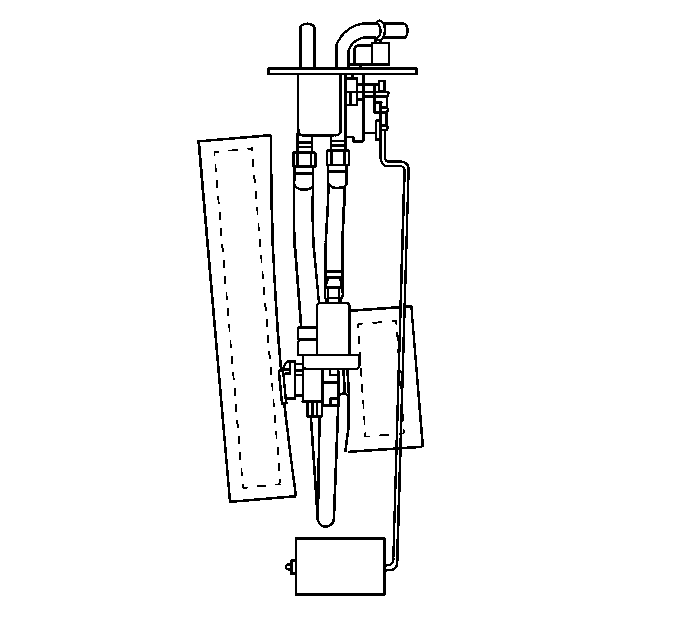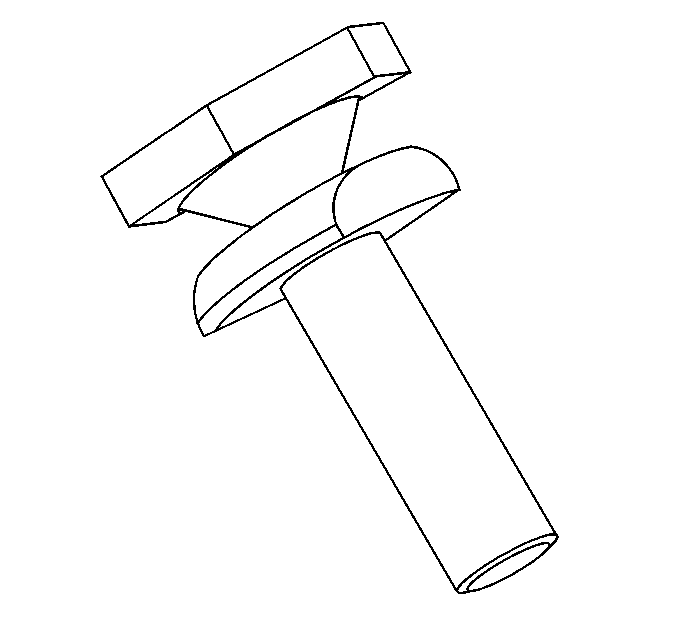Tools Required
| • | J 37088-A Tool
Set, Fuel Line Quick Connect Separator |
Removal Procedure (Left or Right)
Caution: Unless directed otherwise, the ignition and start switch must be in the OFF or LOCK position, and all electrical loads must be OFF before servicing
any electrical component. Disconnect the negative battery cable to prevent an electrical spark should a tool or equipment come in contact with an exposed electrical terminal. Failure to follow these precautions may result in personal injury and/or damage to
the vehicle or its components.
- Disconnect
the negative battery cable.
- Relieve the fuel system pressure. Refer to the
Fuel Pressure Relief
.
Caution: Refer to Vehicle Lifting Caution in the Preface section.
- Raise the vehicle. Refer to
Lifting and Jacking the Vehicle
in General Information.
- Remove the rear wheel and tire assembly. Refer to
Tire and Wheel Removal and Installation
in Tires and Wheels.
- Clean all of the fuel connections and the surrounding areas before
disconnecting the fuel pipes in order to avoid possible contamination of the
fuel system.
- Drain the fuel tanks. Refer to
Fuel Tank Draining
.
- Remove the fuel tank shield.
- Mark or identify each fuel pipe in order to aid in installing
the pipes in their original positions.
- Disconnect the quick-connect fittings from the fuel sender. Refer
to
Plastic Collar Quick Connect Fitting Service
.
- Cap all of the fuel pipes.
- Disconnect the fuel sender electrical connector.
- Remove the fuel tank strap.
- Support the fuel tank.
- Remove the fuel sender attaching bolts. Remove previously installed
"break-away head" service bolts using a 5/16 inch open end wrench.
- Discard the fuel sender attaching bolts.
- Remove the float arm retaining clip and the float arm for the
left fuel sender only.
- Carefully remove the fuel sender with the gasket.
- Discard the fuel sender gasket.
- Clean the gasket sealing surfaces.
Installation Procedure (Right)

Caution: In order to reduce the risk of fire and personal injury that may result
from a fuel leak, always replace the fuel sender gasket and the fuel sender
attaching bolts when reinstalling the fuel sender assembly.
- Install a new fuel sender gasket on the fuel sender.
- Fold the long strainer in half over itself and hold the strainer
in this position.
- Pinch both strainers upward toward each other.
Important: Do not bend or twist the float arm.
- Insert the float arm through the fuel tank opening followed by
the folded strainers.
- Release the strainers once the strainers are in the fuel tank.
The strainers will spring back to their full position.
- Continue inserting the fuel sender through the fuel tank opening.
The fuel sender may need to be rotated in order to facilitate the installation.
| 6.1. | Look through the fuel tank opening to ensure that the long strainer
is visible. |
| 6.2. | If the strainer is not visible, rotate the fuel sender clockwise
and counterclockwise about 90 degrees. Rotating the fuel sender will free
up the strainer. The strainer should become visible at the
tank opening. |

- Align the fuel sender
gasket tab (2) with the fuel sender cover mark (1).
- Align the fuel sender cover mark (1) with the fuel tank
mark.

Notice: Use the correct fastener in the correct location. Replacement fasteners
must be the correct part number for that application. Fasteners requiring
replacement or fasteners requiring the use of thread locking compound or sealant
are identified in the service procedure. Do not use paints, lubricants, or
corrosion inhibitors on fasteners or fastener joint surfaces unless specified.
These coatings affect fastener torque and joint clamping force and may damage
the fastener. Use the correct tightening sequence and specifications when
installing fasteners in order to avoid damage to parts and systems.
- Hand tighten the
new break-away head fuel sender attaching bolts until finger tight.

Important: The upper hex head portion of the fuel sender attaching bolts is designed
to shear off of the lower section of the bolt when the proper torque is reached.
Do not tighten the bolts after the bolt heads have sheared off.
A torque wrench or other special tools are not required. Do not use
thread locking or other types of sealers or lubricants when installing
these bolts and gasket.
- Tighten the fuel sender assembly (1) break-away head attaching bolts
in sequence until the upper hex head portion of the bolts shear off
of the lower section.

- Connect the fuel sender
fuel feed pipe (1) (from the jet pump to the left tank, and the fuel
feed rear crossover pipe (2) from the left tank to the
jet pump). Refer to
Plastic Collar Quick Connect Fitting Service
.
- Connect the fuel sender electrical connector.

- Install the fuel tank
strap (3).
- Install the fuel tank strap bolts (1, 2, 4).
Tighten
- Tighten the bolt (2) to 25 N·m (18 lb ft).
- Tighten the bolt (1) to 25 N·m (18 lb ft).
- Tighten the remaining bolts (4) to 25 N·m
(18 lb ft).

- Install the fuel tank
shield (1).
- Install the fuel tank shield mount bolt (2).
- Install the fuel tank shield mount nut (3).
Tighten
| • | Tighten the fuel tank shield mount bolt to 25 N·m
(18 lb ft). |
| • | Tighten the fuel tank shield mount nut to 12 N·m
(106 lb ft). |
- Install the rear wheel and tire assembly. Refer to
Tire and Wheel Removal and Installation
in Tires
and Wheels.
- Lower the vehicle.
- Refill the fuel system.
- Install the fuel filler cap.
- Connect the negative battery cable.
- Perform the following procedure in order to inspect for leaks:
| 23.1. | Turn the ignition switch ON for 2 seconds. |
| 23.2. | Turn the ignition switch OFF for 10 seconds. |
| 23.3. | Turn the ignition switch ON. |
| 23.4. | Inspect for fuel leaks. |
- Program the transmitters. Refer to
Transmitter Programming
in Keyless Entry.
- Perform the idle learn procedure. Refer to
Idle Learn
.
Installation Procedure (Left)
Important: Always install a new fuel pump strainer before reinstalling the left
fuel sender assembly. A fuel pump strainer that has been exposed to fuel will
not unfold in the fuel tank and may block full travel of the
float arm.

- Install a new fuel pump
strainer in the same position as noted during disassembly. Push on the outer
edge of the strainer ferrule until the strainer is fully seated.
Caution: In order to reduce the risk of fire and personal injury that may result
from a fuel leak, always replace the fuel sender gasket and the fuel sender
attaching bolts when reinstalling the fuel sender assembly.
- Install a new fuel sender gasket on the fuel sender.
- Fold the strainer 3 times so that the amount of space occupied
by the strainer is about equivalent to the diameter of the fuel sender reservoir.
| 3.1. | Fold side 1 of the strainer over side 2. |
| 3.2. | Fold side 3 of the strainer over side 4, and hold
the strainer in the folded position. |
- Insert the fuel sender through the fuel tank opening.
- Release the strainer once the strainer is in the fuel tank. The
strainer will spring back to its full position.
- Continue inserting the fuel sender through the fuel tank opening.
The fuel sender may need to be rotated in order to facilitate the installation.
| 6.1. | Look through the fuel tank opening to ensure that the long side
of the strainer is visible. |
| 6.2. | If the strainer is not visible, rotate the fuel sender clockwise
and counterclockwise approximately 90 degrees. Rotating the fuel sender
will free up the strainer. The strainer should become visible
at the tank opening. |
Important: Do not bend or twist the float arm.
- Insert the float and the float arm into the fuel tank opening.
- Install the float arm retaining clip.

- Align the fuel sender
gasket tab (1) with the fuel sender cover mark (2).
- Align the fuel sender cover mark (2) with the fuel tank
mark.

Notice: Use the correct fastener in the correct location. Replacement fasteners
must be the correct part number for that application. Fasteners requiring
replacement or fasteners requiring the use of thread locking compound or sealant
are identified in the service procedure. Do not use paints, lubricants, or
corrosion inhibitors on fasteners or fastener joint surfaces unless specified.
These coatings affect fastener torque and joint clamping force and may damage
the fastener. Use the correct tightening sequence and specifications when
installing fasteners in order to avoid damage to parts and systems.
- Manually tighten
the new "break-away head" fuel sender attaching bolts until the
bolts are finger tight.

Important: The upper hex head portion of the fuel sender attaching bolts is designed
to shear off of the lower section of the bolt when the proper torque is reached.
Do not tighten the bolts after the bolt heads have sheared off.
A torque wrench or other special tools are not required. Do not use
thread locking or other types of sealers or lubricants when installing
these bolts and gasket.
- Tighten the new "break-away head" fuel sender assembly attaching
bolts in sequence until the upper hex head portion of the bolts shear off
of the lower section.

- Connect the fuel sender
fuel feed pipe (1) from the jet pump to the left tank, to the fuel
return rear pipe (2), and to the fuel feed rear pipe (3).
Refer to
Plastic Collar Quick Connect Fitting Service
.
- Connect the fuel sender electrical connector.

- Install the fuel tank
strap (3).
- Install the fuel tank strap bolts (1, 2, 4).
Tighten
- Tighten the bolt (2) to 25 N·m (18 lb ft).
- Tighten the bolt (1) to 25 N·m (18 lb ft).
- Tighten the remaining bolts (4) to 25 N·m
(18 lb ft).

- Install the fuel tank
shield (1).
- Install the fuel tank shield mount bolt (2).
- Install the fuel tank shield mount nut (3).
Tighten
| • | Tighten the fuel tank shield mount bolt to 25 N·m
(18 lb ft). |
| • | Tighten the fuel tank shield mount nut to 12 N·m
(106 lb ft). |
- Install the rear wheel and tire assembly. Refer to
Tire and Wheel Removal and Installation
in Tires
and Wheels.
- Lower the vehicle.
- Refill the fuel system.
- Install the fuel filler cap.
- Connect the negative battery cable.
- Perform the following procedure in order to inspect for leaks:
| 25.1. | Turn the ignition switch ON for 2 seconds. |
| 25.2. | Turn the ignition switch OFF for 10 seconds. |
| 25.3. | Turn the ignition switch ON. |
| 25.4. | Inspect for fuel leaks. |
- Program the transmitters. Refer to
Transmitter Programming
in Keyless Entry.
- Perform the idle learn procedure. Refer to
Idle Learn
.














